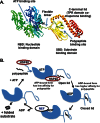The HSP70 family and cancer
- PMID: 23563090
- PMCID: PMC3670260
- DOI: 10.1093/carcin/bgt111
The HSP70 family and cancer
Abstract
The HSP70 family of heat shock proteins consists of molecular chaperones of approximately 70kDa in size that serve critical roles in protein homeostasis. These adenosine triphosphatases unfold misfolded or denatured proteins and can keep these proteins in an unfolded, folding-competent state. They also protect nascently translating proteins, promote the cellular or organellar transport of proteins, reduce proteotoxic protein aggregates and serve general housekeeping roles in maintaining protein homeostasis. The HSP70 family is the most conserved in evolution, and all eukaryotes contain multiple members. Some members of this family serve specific organellar- or tissue-specific functions; however, in many cases, these members can function redundantly. Overall, the HSP70 family of proteins can be thought of as a potent buffering system for cellular stress, either from extrinsic (physiological, viral and environmental) or intrinsic (replicative or oncogenic) stimuli. As such, this family serves a critical survival function in the cell. Not surprisingly, cancer cells rely heavily on this buffering system for survival. The overwhelming majority of human tumors overexpress HSP70 family members, and expression of these proteins is typically a marker for poor prognosis. With the proof of principle that inhibitors of the HSP90 chaperone have emerged as important anticancer agents, intense focus has now been placed on the potential for HSP70 inhibitors to assume a role as a significant chemotherapeutic avenue. In this review, the history, regulation, mechanism of action and role in cancer of the HSP70 family are reviewed. Additionally, the promise of pharmacologically targeting this protein for cancer therapy is addressed.
Figures



References
-
- Daugaard M., et al. (2007). The heat shock protein 70 family: highly homologous proteins with overlapping and distinct functions. FEBS Lett., 581, 3702–3710 - PubMed
-
- Rérole A.L., et al. (2011). Hsp70: anti-apoptotic and tumorigenic protein. Methods Mol. Biol., 787, 205–230 - PubMed
-
- Brodsky J.L., et al. (2006). Hsp70 molecular chaperones: emerging roles in human disease and identification of small molecule modulators. Curr. Top. Med. Chem., 6, 1215–1225 - PubMed
-
- Bonnycastle L.L., et al. (1994). Cloning, sequencing, and mapping of the human chromosome 14 heat shock protein gene (HSPA2). Genomics., 23, 85–93 - PubMed
Publication types
MeSH terms
Substances
Grants and funding
LinkOut - more resources
Full Text Sources
Other Literature Sources
Molecular Biology Databases
Research Materials

